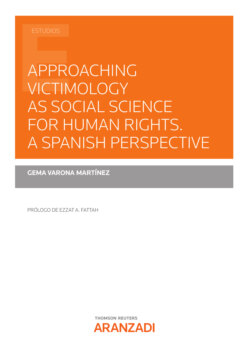Читать книгу Approaching Victimology as social science for Human rights a Spanish perspective - Gema Varona Martínez - Страница 17
1.1. WHAT IS TO BE A VICTIM?
ОглавлениеBeyond the mysteries of its etymological origin, we will concentrate on defining the notion of victim nowadays. We could try to answer this difficult question by saying that to be a victim is to be considered a victim by society and, perhaps, the criminal justice system. The notion of the victim always entails the interaction between a subjective (self-perception about the meaning, seriousness and impact of harm, its injustice and the need for redress) and an objective dimension with individual, group and collective elements and processes involved. The objective dimension of the status of victim is its link to different concepts according to the discipline considered and is related to the notion of victimhood as the acknowledgement of the status of victim. In all dimensions, we have to consider the hegemonic hidden victimisation.
Image 7: Objective, subjective and social dimensions in the processes of victimisation and de-victimisation
Image 8: Victimhood and hidden victimisation
In relation to the objective dimension, from the standpoint of Criminal law we talk about victims of crime (and abuse of power). From that of Psychology, we usually refer to victims of trauma or traumatic events. From Philosophy, we consider the notion of suffering. From Medicine, we can add the notion of pain. Finally, beyond the strict concept coming from Law, within a more broad Criminology (or Zemiology, Tomb, 2018) –meaning capturing social dimensions–, we can talk about the harm produced to victims.
Image 9: Notions related to the objective dimension of victimisation/de-victimisation coming from different disciplines or branches of knowledge
According to the 1985 United Nations Declaration of Basic Principles of Justice for Victims of Crime and Abuse of Power (Resolution A/RES/40/34, adopted by the General Assembly), victims of crime mean:
1. “(...) persons who, individually or collectively, have suffered harm, including physical or mental injury, emotional suffering, economic loss or substantial impairment of their fundamental rights, through acts or omissions that are in violation of criminal laws operative within Member States, including those laws proscribing criminal abuse of power.
2. A person may be considered a victim, under this Declaration, regardless of whether the perpetrator is identified, apprehended, prosecuted or convicted and regardless of the familial relationship between the perpetrator and the victim. The term “victim” also includes, where appropriate, the immediate family or dependants of the direct victim and persons who have suffered harm in intervening to assist victims in distress or to prevent victimisation.
3. The provisions contained herein shall be applicable to all, without distinction of any kind, such as race, colour, sex, age, language, religion, nationality, political or other opinion, cultural beliefs or practices, property, birth or family status, ethnic or social origin, and disability”.
In relation to Part B of that UN Resolution, victims of abuse of power mean:
“18. “Persons who, individually or collectively, have suffered harm, including physical or mental injury, emotional suffering, economic loss or substantial impairment of their fundamental rights, through acts or omissions that do not yet constitute violations of national criminal laws but of internationally recognized norms relating to human rights.
19. States should consider incorporating into the national law norms proscribing abuses of power and providing remedies to victims of such abuses. In particular, such remedies should include restitution and/or compensation, and necessary material, medical, psychological and social assistance and support”.
There remains a crucial aspect on the topic of the objective dimension of the notion of the victim, particularly if considered the initial definition of Victimology provided in this book. That objective dimension should not be restricted to the crime/victimisation, traumatic event/suffering/harm, but, as part of that objective dimensions, the justice/reparation/recovery/emancipation processes should be included, beyond a linear thought of steps where one phase (victimisation) progressively follows the other (de-victimisation). The reality is that on many occasions the de-victimisation (Echeburúa and Cruz, 2015) or reparation has to do with previous individual and social experiences, or with experiences that happened right after what is called crime or around its immediate impact. If we focus only on a static definition and understanding of crime, we will not truly comprehend the processes of victimisation and its aftermath. When stating the need for justice of victims, it should be considered that there are many conceptions and definitions of justice (social justice, criminal justice, punitive justice, restorative justice, procedural justice, ecological justice, and etcetera). In order to be more comprehensive, some of them find it necessary to depart from the concrete experience of the injustice suffered by the victims (Braithwaite, 2020, p. 19; Reyes Mate, 2011; Shklar, 1990; Pemberton, 2020), instead of abstract legal or philosophical notions of justice.
